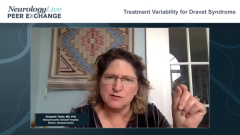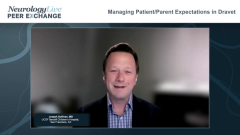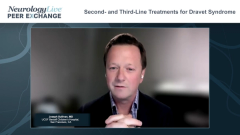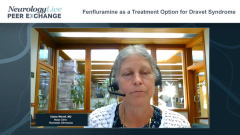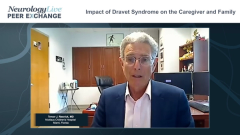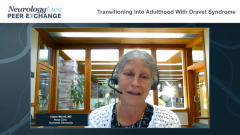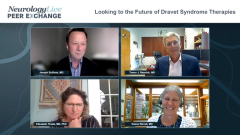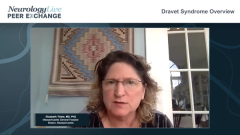
Transitioning Into Adulthood With Dravet Syndrome
Elaine Wirrell, MD, reviews the transition of care into adulthood of patients with Dravet syndrome and how this transition can affect the patient, caregiver, and care provider.
Episodes in this series

Joseph Sullivan, MD: Trevor, you mentioned your 25-year-old patient. I always feel that, as a pediatric epileptologist, I don’t want to ignore that this is a childhood-onset epilepsy. But these children do become young adults, and that is often a difficult time as we pass the torch to our adult epilepsy colleagues. It’s not only difficult for the adult epilepsy colleagues who are often on the receiving end, but very difficult for the family to be under our care for 15 or 20 years and then have to switch. Elaine, can you share your experience or comment on what you feel are some of the most important things that we need to be mindful of when we think about that transition?
Elaine Wirrell, MD: You’re right. It is a very worrisome time for many families. They know us. We’ve been with them typically since the beginning. They know that we are involved in different research. They know we’ve been involved with other families who have a child with Dravet syndrome. They look at us as somebody who knows a fair bit about Dravet syndrome, so moving on to a new person is pretty anxiety-provoking. The important thing about transition is that we do this as a well-organized process. It’s not something that happens in a single day, where you suddenly stop seeing me and you go and see one of my adult colleagues. It’s a process that happens over months to years.
It’s important to work with families to help them understand why that process is important. There are 2 big reasons why it’s important. First of all, your young adult with Dravet syndrome is going to develop medical problems that are more in keeping with an adult than a child. As a child neurologist, I do not feel well empowered to deal with hypertension or a lot of the adult-onset medical issues that those patients will get. Secondly, many of our pediatric hospitals have an upper age limit, beyond which we cannot admit. It’s crucial for these families to have that adult team set up before they’re in a medical crisis. We don’t want those patients being admitted to an adult center where we can’t actually see them and we don’t have any hospital privileges, and they’re having to meet a new adult team in that moment of crisis. If we can plan and do that ahead of time, that’s important.
The process we initially go through with the transition is making sure families understand how Dravet syndrome evolves as the child goes from a child to a teenager and from a teenager to an adult. We see a difference in seizures. In young adulthood, many of the patients are having briefer convulsive seizures at night as opposed to absences, myoclonic, or prolonged seizures. They become much less frequent. They can develop more gait issues and Parkinsonian features. They can develop behavioral issues. Those are all important to address to ensure families understand what to expect at the different ages.
The other important thing is having them work with a social worker who is very knowledgeable in working with children with developmental and epileptic encephalopathies, so they understand the importance of guardianship to make sure they’re not cut off from medical records when the child turns 18 and they understand the insurance changes when you become a young adult. We don’t want any lapse in insurance trust funds, if those need to be set up.
As far as what we can do to make that process easier, if you look at 1 emergency department visit, that probably generates 100 pages of medical records. If we’re sending these patients on to our adult colleagues, it’s important that we provide them with a succinct transition document—a 2 to 3 page summary that summarizes this patient well—and that they have that before they meet the patient. It should summarize what medications they are on, which ones they have been on previously, and why those were stopped. Did they have [adverse] effects? Are they on dietary therapy? That will need to be planned for when they go to the adult side. What other comorbidities do they have? If we can provide that 2 to 3 page summary document, that’s super helpful for our adult colleagues.
Joseph Sullivan, MD: I agree completely. We’re working on that, along with one of our residents who is trying to do a transition toolkit, which is a living document that lives as we update it. Getting back to that caregiver impact, those things often don’t get included in the handoff in terms of maybe the PTSD [post-traumatic stress disorder] that some of these families are feeling and where they are in terms of their psychological well-being. That’s going to be very important as an adult neurologist tries to pivot and make another treatment recommendation but doesn’t have that relationship. It’s important for them to understand that context.
I’ll just make one other comment about adulthood. It’s a little related in the sense that it’s now our job as a Dravet community to try to educate our adult neurologists about what the signs are of someone they have in their clinic who could have undiagnosed Dravet syndrome. We would all agree it morphs and maybe looks like a more nondescript epilepsy. We often don’t have the luxury of having the early childhood history that we started with. In a lot of ways, if you have a young adult with refractory epilepsy and intellectual disability and you don’t know why, that patient needs genetic testing. Some of them are going to have SCN1A mutations, and then you go back and ask the questions, and they are going to fulfill criteria for Dravet syndrome. Now more than ever with these newer therapies, it can really make a difference in terms of how we treat them.
Thank you for watching this NeurologyLive® Peer Exchange. If you enjoyed the content, please subscribe to our e-newsletters to receive upcoming Peer Exchanges and other great content right in your inbox. Thank you.
Transcript Edited for Clarity
Newsletter
Keep your finger on the pulse of neurology—subscribe to NeurologyLive for expert interviews, new data, and breakthrough treatment updates.


